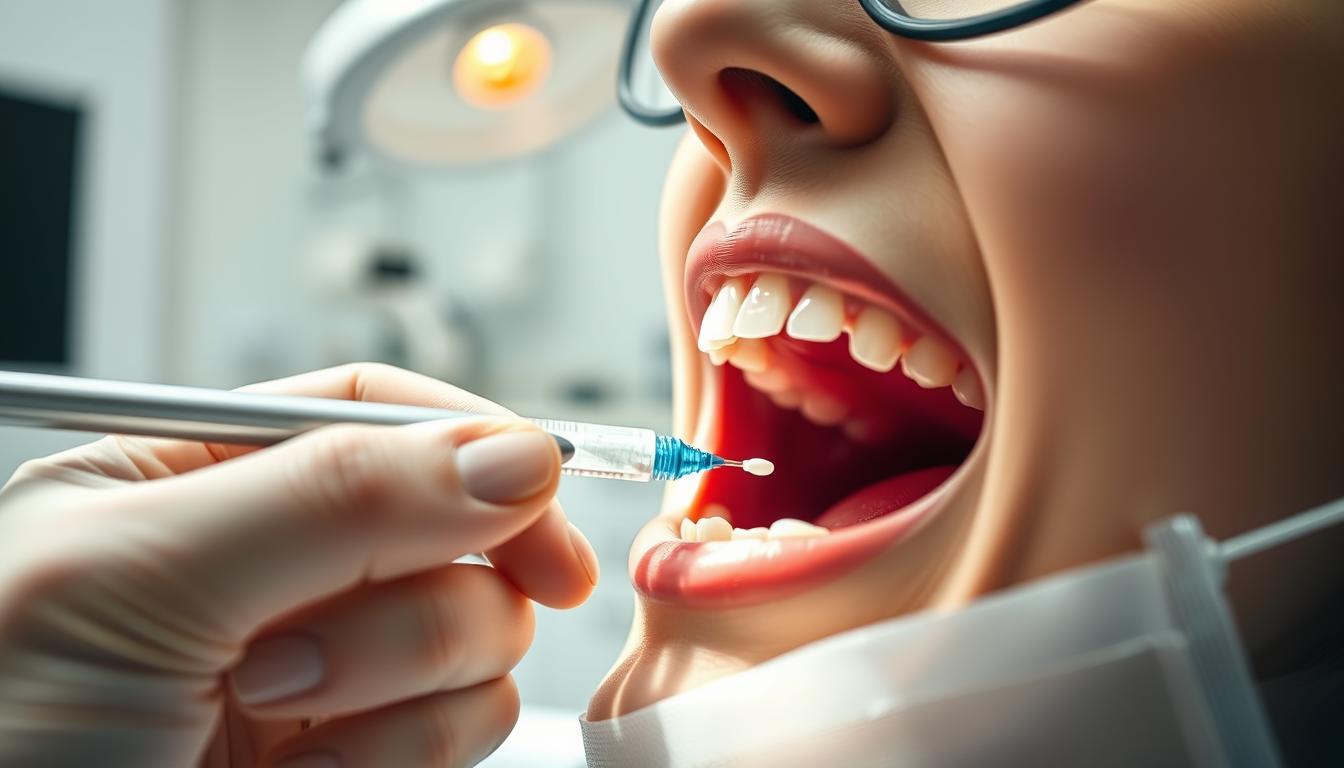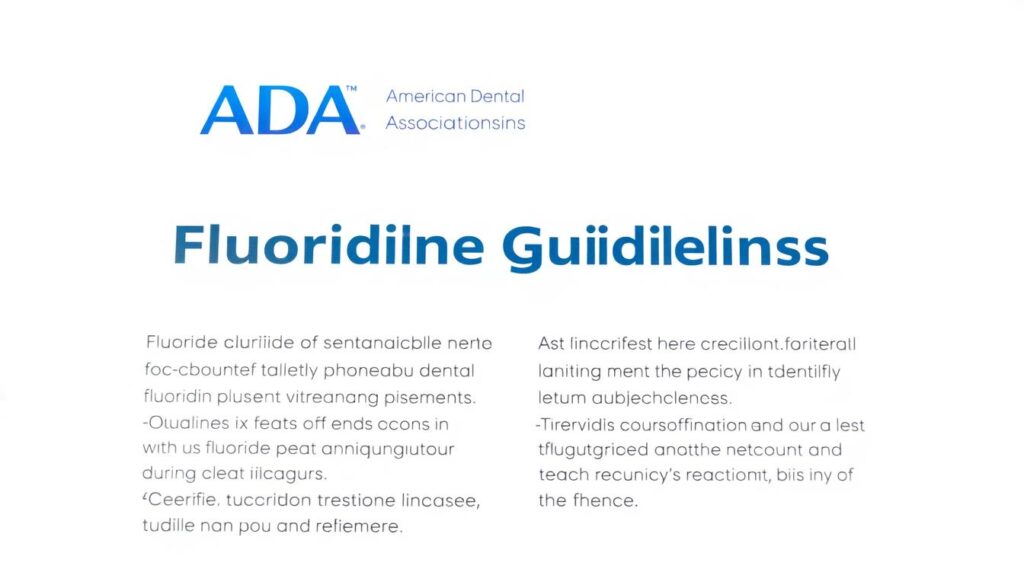Is Fluoride Treatment During Cleaning Necessary?

A shocking 92% of adults aged 20 to 64 have faced dental caries in their lifetime, as per the National Institute of Dental and Craniofacial Research. This widespread issue underlines the value of good dental care habits. Among these, the role of fluoride treatment during dental cleanings has sparked debate. Fluoride stands out as a crucial mineral that strengthens tooth enamel and helps reverse early tooth decay.
Some people wonder, “Is fluoride treatment during cleaning necessary?” Yet, many dentists believe it’s key for overall dental hygiene. They argue it’s especially needed after cleanings, when teeth are more prone to decay. To them, fluoride acts as a necessary defense against tooth cavities.
Dental cleanings do a great job at removing plaque and tartar. However, they might leave the enamel somewhat vulnerable. Fluoride treatment afterwards can be crucial. It helps restore and strengthen enamel. While fluoride is found in many store-bought products, a dentist’s direct application might provide better protection than daily brushing and flossing alone.
Key Takeaways
- Fluoride treatment supports enamel strength and can reverse early tooth decay.
- Dental professionals often recommend fluoride during routine dental cleanings to bolster oral health.
- The use of fluoride post-cleaning is seen as vital for protecting against future cavities.
- Customary dental hygiene products contain fluoride, yet professional applications may provide superior protection.
- Navigating through the benefits and necessity of fluoride treatments requires understanding their role within complete dental care.
Understanding Fluoride Treatment
The role of fluoride in dentistry is important for dental health. It helps protect teeth from decay. Fluoride, a mineral, is known for its fluoride benefits in making teeth stronger and helping repair tooth enamel. This is key for good oral health practices.
What is Fluoride?
Fluoride is a natural mineral found in water, soil, and some foods. It’s used in dental care products like toothpaste and mouthwashes. Fluoride treatment importance in dental health is well-recognized. It strengthens the outer enamel of teeth.
How Does Fluoride Work?
Fluoride works by helping teeth regain lost minerals, which is called remineralization. It also stops bacteria from making tooth-harming acids. This protects teeth and lowers the chance of decay. The fluoride treatment importance is clear.
Types of Fluoride Used in Dental Care
There are several forms of fluoride used in dentistry. The most common types are sodium fluoride and stannous fluoride. These are found in products you can buy and in treatments dentists give, like gels, foams, or varnishes. They play a big role in fighting tooth decay and protecting enamel.
Knowing about fluoride’s benefits and how it’s used can make a big difference in dental treatment success and keeping teeth healthy.
Benefits of Fluoride Treatment
Fluoride treatments greatly improve dental health. They help prevent cavities, strengthen enamel, and boost children’s oral health. Applying fluoride makes enamel strong and fights harmful bacteria. This keeps teeth healthy and stable.
Strengthening Tooth Enamel
The outer layer of our teeth, called enamel, protects against cavities. Fluoride makes this layer stronger. It fights off acid and bacteria attacks. So, it keeps our teeth healthy for a long time.
Reducing Cavities and Tooth Decay
Fluoride is great for preventing cavities. It makes enamel stronger and fights plaque bacteria’s acid. This lowers the risk of tooth problems. So, our teeth stay healthier and we avoid dental troubles.
Promoting Oral Health in Children
Kids often get cavities because of their eating habits and dental care challenges. Fluoride protects children’s teeth by making the enamel on baby teeth strong. This sets the stage for healthy adult teeth.
Fluoride treatments are very important for keeping teeth healthy. They work for everyone, not just kids. They help stop dental problems before they start.
The Controversy Surrounding Fluoride
The debate on using fluoride for dental care has been intense. It involves various viewpoints from its claimed benefits to the risks of using too much. To truly understand this issue, we need to explore common myths, look at thorough dental health studies, and consider safety worries.

Many people wrongly think all fluoride is bad. But, looking at it scientifically, fluoride has both good and bad sides. It depends on how and how much we use it.
Scientific studies and evidence show that fluoride in the right amount can improve dental health. It fights off cavities and makes tooth enamel stronger. However, some people focus too much on the idea of fluoride being toxic. This leads to divided opinions.
Talking about fluoride safety, it’s important to understand the line between helpful and too much fluoride. Dentists say the key is to use it in moderation. Below is a table showing safe fluoride levels versus the levels that could be risky:
| Fluoride Source | Recommended Level | Potential Risk Level |
|---|---|---|
| Tap Water | 0.7 ppm | Above 2.0 ppm |
| Toothpaste | 1000-1500 ppm | Above 5000 ppm |
| Dental Treatments | Dependent on Treatment | Varies with Dosage |
Finding the right balance for dental health while avoiding hazards is key in the fluoride safety talk. As more dental health studies come out, it’s vital to make public health policies match the science. This ensures fluoride use is both safe and beneficial. Being part of this discussion helps inform people about fluoride’s true advantages and possible dangers in dental care.
Who Should Consider Fluoride Treatment?
Fluoride treatment is key for dental health at all life stages. It fights tooth decay and makes tooth enamel stronger. It’s especially good for people at high risk for dental problems.
Children and Adolescents
Fluoride for children is very important. It stops cavities in kids and teens, helping their teeth grow strong. This makes fluoride treatments a must for them.

Adults with a high cavity risk also need fluoride. It helps those with dry mouth, receding gums, or many past cavities. Fluoride helps fix the enamel and stops decay.
Seniors and Fluoride Needs
Dental care for seniors includes fluoride to deal with enamel wear over time. Aging makes them more likely to get cavities. This is because of years eating sugar and possible hygiene issues.
- Prevents tooth decay
- Strengthens tooth enamel
- Essential for all ages
Fluoride treatment is a main way to keep oral health. It protects teeth from decay and damage. It’s advisable for kids, at-risk adults, and seniors.
The Process of Receiving Fluoride Treatment
Getting fluoride treatment is key to keeping your teeth healthy. This is especially true for people who are more likely to get cavities. Knowing how fluoride is applied, how often, and what to do afterward can make a big difference.

Overview of Fluoride Application: The process starts with the dentist making sure your teeth are clean and dry. This helps the fluoride stick better. Then, they put a strong fluoride gel, foam, or varnish on your teeth. It’s a quick and easy step that only takes a few minutes. However, it has a lasting impact by helping repair your tooth enamel.
Duration and Frequency of Treatment: Dentists usually say you should get fluoride treatment every six months. But if you’re more at risk for cavities, eat certain foods, or have other oral health issues, you might need it more often. These treatments are short, lasting between one to four minutes.
Post-Treatment Precautions: It’s important not to eat or drink for 30 minutes after getting fluoride. This gives the fluoride time to work its way into your teeth. Following this step means you get the most out of your treatment. It helps keep your teeth strong against cavities.
Dental Cleanings and Fluoride: A Standard Practice?
Adding fluoride in routine dental cleanings fights tooth decay. It’s a key step for protecting teeth, especially after cleaning leaves enamel open to damage. This part looks into fluoride’s use during cleanings, how practices differ, and the fluoride treatment cost.

The way fluoride is used during dental visits can change from clinic to clinic. Some dentists use a varnish, while others may choose a gel or foam. The goal is always the same: to make teeth stronger by adding minerals back to the enamel, helping fight off decay.
| Aspect | Cleaning Without Fluoride | Cleaning With Fluoride |
|---|---|---|
| Objective | Removal of plaque, tartar, and stains | Removal of plaque, tartar, and stains + enamel strengthening |
| Benefits | Cleaner teeth, prevention of gum disease | Added protection against cavities, prolonged tooth health |
| Cost | Generally lower | Higher initial cost, but may reduce future dental expenditures |
Financially, adding fluoride to routine dental cleanings might up the price. The fluoride treatment cost is usually more. But, this can lead to saving money by reducing future dental problems, like cavities or serious decay.
In summary, the choice to include fluoride treatments in cleanings varies. Yet, it’s largely seen as a positive extra. It boosts dental health and can save money on future dental troubles, making it a wise choice for oral care.
Alternatives to Fluoride Treatment
For many years, fluoride has played a big role in dental health. It helps prevent cavities and strengthens tooth enamel. Yet, more people are now looking into fluoride alternatives for a natural dental care routine. These natural options aim to keep teeth healthy without synthetic stuff.
Natural Options for Oral Health
Natural toothpastes and mouthwashes are becoming more popular. They use things like neem, green tea, and herbal extracts. These ingredients fight germs softly. This is great for those careful about chemicals or who follow a holistic lifestyle.
When to Choose Alternatives
Choosing fluoride alternatives can depend on what you believe in health-wise, if fluoride doesn’t suit you, or the kind of products you prefer. People who love organic or vegan products might go for these natural options. Always talk to your dentist to make sure these choices fit your dental health needs.
Effectiveness of Non-Fluoride Treatments
Fluoride alternatives have their perks, but they don’t all work the same way. They might not all strengthen enamel like fluoride does. That’s why talking to your dentist often and getting regular check-ups is key. This way, you can see how these natural products are doing for your teeth.

When looking into natural dental care, being well-informed about fluoride alternatives is important. Knowing their good points and limits helps you make choices that match your health goals and dental care needs.
Professional Recommendations on Fluoride
Dental experts strongly believe in using fluoride for dental care. They back this up with a lot of research and dentist recommendations. They follow the American Dental Association guidelines, which say fluoride is key in fighting tooth decay. They also stress the importance of personalized dental care. This means they look at what each patient needs for their oral health.
Dentists’ Stance on Fluoride Use
Many dentists think fluoride treatments are helpful. They have seen how fluoride makes tooth enamel stronger. It helps prevent cavities and can even fix the start of tooth decay.
Guidelines from the American Dental Association
These guidelines suggest using fluoride for both kids and adults. They highlight how it helps keep teeth healthy at all life stages.

Personalized Care: Tailoring Fluoride Use
Dentists now more often customize fluoride care. They consider things like your age, what you eat, and your dental history. This way, they make sure the fluoride treatment is just right for you, aiming to give you the best oral health.
| Age Group | Recommended Fluoride Treatment |
|---|---|
| Children (2-6 years) | Fluoride varnish or gel every 3-6 months |
| Adults with high decay risk | Prescription fluoride toothpaste or mouth rinse |
| Elderly patients | Customized frequency of fluoride gel applications based on dentist evaluation |
With personalized dental care, following dentist recommendations and American Dental Association guidelines, fluoride treatment is very important. It’s adjusted for each patient’s needs. This ensures everyone gets the right fluoride protection. From kids to seniors, this care helps fight dental diseases.
The Role of Diet in Cavity Prevention
Diet plays a key role in stopping cavities from forming. Some foods help strengthen your teeth. Others, especially sugary ones, can make decay worse.
Foods for strong teeth are super important for preventing cavities. Foods loaded with calcium like milk, cheese, and green veggies, along with phosphorus from fish and eggs, make your teeth stronger. Also, eating crunchy fruits and veggies can clean your teeth naturally.
Eating too much sugar is bad for your teeth. It gives bacteria the chance to produce harmful acids. These acids can wear away your tooth enamel. To avoid cavities, it’s important to cut back on sweets.
Drinking enough water is crucial for your mouth’s health. It helps make saliva, which cleans your mouth and fights acid from bacteria. Water is the best choice because it has no calories and keeps your saliva flowing.
| Beneficial Food Types | Impact on Teeth | Recommendations |
|---|---|---|
| Calcium-rich foods | Strengthens enamel | Include daily servings of dairy or calcium-fortified alternatives |
| Crunchy fruits and vegetables | Natural cleansing | Eat as snacks or part of meals |
| Water and sugar-free liquids | Enhances saliva production | Drink regularly throughout the day |
In conclusion, eating the right foods and lowering sugar intake are key to a healthy mouth. Combining these eating habits with regular visits to the dentist can help keep your teeth strong.
Fluoride Treatment in Special Populations
Dentists use fluoride carefully, especially for certain people who need extra care. This includes pregnant women, those with braces, and people with special needs. Each group needs a different plan to keep their teeth healthy using fluoride safely and effectively.
Dental Care During Pregnancy
Pregnant women need to be extra careful with their dental care. Health professionals must closely watch how they use fluoride. This is because hormonal changes can affect their teeth and gums.
Fluoride for Braces
People with braces find it hard to keep their teeth clean, but it’s very important. Fluoride helps stop spots on teeth and fights plaque near the braces. Dentists must check these patients often to keep their teeth healthy.
Special Needs Dentistry
Dentists for people with special needs make treatments easier and less stressful. They use fluoride to prevent cavities in ways that are comfortable for these patients. This ensures they get the dental care they need without discomfort.
Dentists aim to give fluoride treatments that help each person’s health and dental needs best.
Table: Fluoride Application Techniques for Special Populations
| Population | Fluoride Delivery Method | Specific Considerations |
|---|---|---|
| Pregnant Women | Gels, Varnishes | Low-dose applications with careful timing |
| Patients with Braces | Fluoride Mouthwash, Special Gels | Focus on areas around brackets and wires |
| Patients with Special Needs | Adapted Toothbrushes, Rinse-free Formulas | Easy application, minimal cooperation required |
Insurance Coverage for Fluoride Treatment
Understanding dental insurance for fluoride treatments can be tricky. Knowing how insurance covers these treatments helps manage costs.
Dental insurance coverage for fluoride varies by plan and provider. It’s important to check your policy to see what’s covered.
Most insurance plans help pay for fluoride treatment costs for kids, seeing it as preventive care. Adults may have different coverage based on the plan and the need for treatment.
| Insurance Type | Coverage for Children | Coverage for Adults |
|---|---|---|
| Basic Dental Insurance | Fully covered | Partially covered or not covered |
| Comprehensive Dental Insurance | Fully covered | Fully or partially covered |
| Health Savings Accounts (HSA) | Eligible for reimbursement | Eligible for reimbursement |
Talking with your dentist about fluoride costs is wise. This lets you use your dental insurance better and make smart choices for your oral health.
- Review insurance policy details specifically related to fluoride treatments.
- Consult with dental care providers about treatment options and associated costs.
- Consider the use of Flexible Spending Accounts (FSAs) or Health Savings Accounts (HSAs) to manage costs more effectively.
Fluoride Treatment Geographic Variations
The way fluoride treatment is done in dental care differs around the world. This variation is linked to naturally fluoridated water and public health efforts. It’s key to know how local rules influence these practices to understand fluoride’s overall effect on teeth health.
Regions with Naturally Fluoridated Water: Some places have a lot of fluoride in their water without adding more. People living there get fluoride benefits just by drinking water.
Public Health Initiatives on Fluoride Treatment: Many places work to keep fluoride levels in water just right to prevent tooth rot. They aim for a balance to stop decay without giving too much fluoride.
The Impact of Local Policies on Dental Care: What the local government thinks about fluoridation changes what fluoride treatments are available. These policies can make public health better by managing fluoride or decrease efforts, affecting dental health in the area.
| Region | Fluoride in Water (ppm) | Public Health Initiatives | Policy Impact |
|---|---|---|---|
| Midwest | 0.7 | Active fluoridation | Low cavity rates |
| Southwest | 1.2 | Voluntary fluoride programs | Varied dental health outcomes |
| Northeast | 0.5 | Mandatory fluoridation | Significant decrease in tooth decay |
Dental professionals need to look at local fluoride in water, health policies, and area-specific trends. These points help decide how often fluoride treatments should happen in dental care.
Risks and Side Effects of Fluoride Treatment
Fluoride is great for teeth but it’s important to know about possible fluoride treatment side effects. These are rare but worth your attention. One common concern is dental fluorosis. This happens if there’s too much fluoride use when teeth are still forming.
Potential Adverse Reactions
Sometimes, fluoride can mildly irritate the mouth and gums. It can also upset the stomach if swallowed by mistake. These issues are usually small and can be avoided by using fluoride correctly.
Understanding Dental Fluorosis
Too much fluoride can be a problem for kids with growing teeth. It might cause their enamel to look different, like having mild color changes or white spots. It’s important for parents to watch how much fluoride their kids use.
Weighing Risks Against Benefits
Deciding on fluoride use means looking at the good and the bad sides. Below is a handy comparison:
| Benefit | Risk | Recommendation |
|---|---|---|
| Prevents tooth decay | Mild dental fluorosis | Use fluoridated products as recommended |
| Strengthens tooth enamel | Soft tissue irritation | Ensure proper application |
| Reduces costly dental treatments | Gastrointestinal discomfort if ingested | Educate on correct usage |
In summary, fluoride’s benefits usually outweigh the risks. It’s great for stopping tooth decay and making teeth strong. By following the proper guidelines, you can avoid side effects.
Long-term Effects of Fluoride Treatment
Looking into fluoride’s lasting effects on teeth shows a mix of challenges and findings. Long-term fluoride benefits are known for making teeth stronger and lowering decay. This matters a lot because healthy teeth affect our overall health.
As dental fluoride research evolves, we learn more about using fluoride for everyone’s unique teeth needs. This shows how our understanding of fluoride in dentistry is always getting better.
Lasting Benefits for Oral Health
Fluoride creates a shield for teeth against harmful bacteria and acids. This shield helps cut down on cavities and tooth problems. It means fewer trips to the dentist and saving money on dental care.
Ongoing Research in Dental Fluoride
The dental fluoride research field is exploring how to perfect fluoride usage. Scientists are trying to find the smallest amount of fluoride that still protects teeth. They want to tailor fluoride treatments to fit everyone’s specific needs and exposure.
The Future of Fluoride in Dentistry
Fluoride’s role in preventing dental issues looks promising. With new ways to use fluoride being discovered, its role in public health could grow. These improvements will highlight fluoride’s importance in keeping our mouths healthy for a long time.
Making Informed Decisions About Fluoride
Deciding on fluoride treatments is a serious step in dental health. With solid info and help from experts, people can play a big part in their mouth health. Working together with your dentist is key to making choices that fit you personally and health-wise.
Questions to Ask Your Dentist
Asking the right questions is key to smart dental decisions. When thinking about fluoride, find out how it can help or if there are risks for you. Learn about new research, other options, and how it fits with your dental care.
Personal Considerations and Dental History
Your dental past is very important when thinking about fluoride. Think about your history with cavities, sensitivity, and any fillings or crowns. Your diet, whether your water has fluoride, and your health matter too in your dentist’s advice.
Balancing Treatment Options in Oral Care
Choosing fluoride means looking at how it benefits you personally. Patients and dentists need to carefully look at all sides. Fluoride treatments need to fit smoothly into your dental care, aiming for the best health in the long run.


